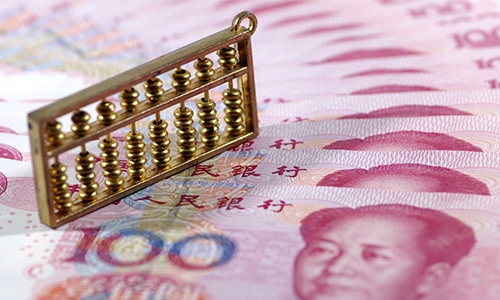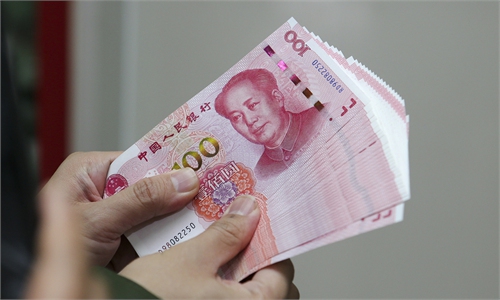China ratchets up key parameter to foster cross-border financing in fresh boost for yuan
Effort to 'anchor' Chinese currency amid pressure

Renminbi Photo: VCG
China on Tuesday decided to ratchet up a key parameter in its macro-prudential policy toolkit to foster cross-border financing by domestic institutions. The upward revision, the first such move in two and a half years, intends to increase US dollar liquidity within the country and consequently stabilize the yuan, observers said.
The Tuesday announcement, adding to measures already taken to bolster the yuan earlier this year, is expected to anchor the Chinese currency and give it stronger defense against the pain-spreading greenback, observers noted, expecting further strong moves in case of any unreasonable depreciation pressure on the yuan.
The People's Bank of China (PBC), the country's central bank, and the State Administration of Foreign Exchange (SAFE), the forex regulator, decided to revise up the macro-prudential adjustment parameter for cross-border financing to 1.25 from 1, read a PBC statement.
The revision aims to broaden sources of cross-border capital for businesses and financial institutions, and encourage them to improve their asset and liability structure, the statement said.
Also on Tuesday, the PBC revealed key takeaways from a Monday meeting, which called for deeper market-based forex reforms and increased yuan exchange rate flexibility to keep the yuan basically stable at a reasonable and balanced level.
The meeting also called for stronger collaboration among different departments and safeguarding the healthy development of the stock, bond and housing markets.
The hiked parameter suggests a higher upper limit of outstanding cross-border financing that businesses and financial institutions will be entitled to, increasing domestic forex supplies and accordingly stabilizing the yuan, experts said.
The move, which comes at a time when the yuan faces renewed depreciation pressure, will make it easier for domestic firms to raise funds from overseas markets, and more capital inflows could alleviate some of the yuan's pressure, Xi Junyang, a professor at the Shanghai University of Finance and Economics, told the Global Times on Tuesday.
"The fresh move is one of the central bank's effective tools in coping with the yuan's fluctuations amid a strengthened US dollar," Xi said.
Briefly after the announcement, the offshore yuan strengthened by more than 160 pips to slightly over 7.3 before gradually trending down.
The yuan's daily fixing was set at 7.1668 against the US dollar on Tuesday, official data showed, obviously weaker than the previous day's 7.123.
The parameter was most recently revised in January 2021 when the PBC and the SAFE lowered the multiplier to 1 from 1.25 for enterprises. A similar downward revision was applied to financial institutions in December 2020.
The previous upward revision was in March 2020 when the parameter was raised to 1.25 from 1 across the board.
The yuan could face further downward pressure and may fall to as low as 7.4 and hover around that level as the US Federal Reserve may continue its drastic rate hikes, Xi predicted, while stressing the depreciation risk is manageable and limited, supported by a recovering domestic economy.
The Chinese economy has strong resilience and sufficient potential and broad leeway, and its fundamentals - which are turning for the better over the longer term - won't change, according to read-out of a Monday meeting presided over by Guo Shuqing, chairman of the China Banking and Insurance Regulatory Commission (CBIRC).
The country's financial risks remain generally converged and the financial system is overall stable, the meeting said, according to a CBIRC statement on Tuesday.
The strengthening of the yuan over the long run won't change as the country's sustained surplus in its international balance of payments and huge net assets in its overseas investments underpin a stable yuan, per the banking and insurance regulator.
The cross-border macro-prudential adjustment ratio was designed to manage risks for Chinese firms and financial institutions in the overseas markets. A relaxation at this time also demonstrates Chinese regulators' confidence in handling risks and their determination in financial opening-up amid external complexities, Dong Dengxin, director of the Finance and Securities Institute of the Wuhan University of Science and Technology, told the Global Times on Tuesday.
Dong pointed out that China's abundant foreign reserves, the largest in the world, also serve as a "strong backup" for cross-border financing.
China's foreign reserves reached $3.029 trillion at the end of September, $25.9 billion less than in August, a decline of 0.85 percent, the SAFE said on October 7.
Thus far, the PBC has taken a "mild" approach to coping with a weakening yuan, but it is not ruled out that more "aggressive means" might be used to stabilize the Chinese currency's exchange rate in the future, according to Xi.
China has more things in its toolbox than other major economies, such as Japan. If the volatility of the foreign exchange market further intensifies, possible measures include increasing the scale of overseas bill issuances, adjusting the counter-cyclical factor, and cutting the foreign exchange reserve requirement ratio. These can all be used, Xi said.
In late September, the PBC announced plans to raise the risk reserve requirement for forward forex trading to 20 percent from zero previously, in an effort to underpin the yuan's stability amid the US dollar's engulfing strength.
Earlier in September, the central bank announced that it would cut financial institutions' forex requirement ratio by 2 percentage points to 6 percent. In April, the PBC announced plans to trim the foreign exchange reserve requirements for financial institutions by 1 percentage points to 8 percent.



